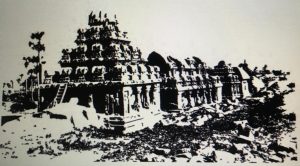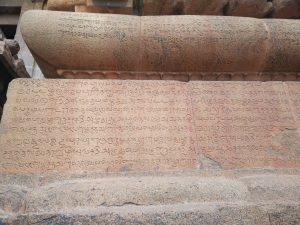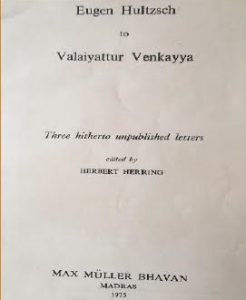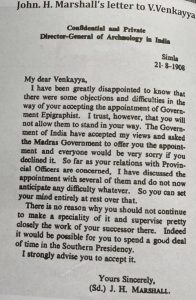There was a time not too long ago when the Chola emperor was forgotten. Then came V Venkayya, a pioneering epigraphist and historian.

Tamil scholar U Ve Swaminatha Iyer on V Venkayya in one of the early editions of his autobiographical 'En Sarithiram' (Sunitha Madhavan)
Raja Raja Chola and his magnificent temple for Siva in Thanjavur have captured the imagination of history buffs in India, especially Tamil Nadu.
The film Ponniyin Selvan, in which a fictional version of the Chola emperor will be one of the protagonists, is eagerly anticipated.
Kalki, the author of the historical novel ‘Ponniyin Selvan’ on which the film is based, is perhaps still the most popular writer in Tamil Nadu, 60 years after he passed away.
But few have heard of V Venkayya, an epigraphist and historian, who along with Eugen Hultzsch, rediscovered the long-forgotten Raja Raja.
In the early 20th century, the name of the king who built the big temple of Thanjavur was not known; some believed it was built by Karikala Chola, who lived in the Sangam age, around 1,000 years before Raja Raja.
Hultzsch, a German Sanskrit scholar, was hired by the Government of Madras as its chief epigraphist. He was attempting to read the Pallava dynasty inscriptions in Mamallapuram (Mallai or Kadal Mallai or Mahabalipuram), at the monoliths now called the Pancha Rathas, one day in December 1886.
Venkayya, a physics graduate from the Madras Christian College, was then employed as a school teacher in Kanchipuram, the capital of the erstwhile Pallavas. He was merely a tourist that day. He was astounded seeing a European trying to read an inscription and offered to assist him.

German scholar Eugen Hultzsch first met V Venkayya, in Mamallapuram, at the site of the five monolithic temples now called the Pancha Rathas (Annual Report, Archaeological Survey Of India, 1910-11)
Impressed by the curiosity, ability, and enthusiasm of Venkayya, Hultzsch asked the latter to quit his job as a school teacher and join the fledgling epigraphy department of the Archaeological Survey of India (ASI) in Bangalore.
Venkayya was naturally hesitant. But he saw a once-in-a-lifetime opportunity. So he waited until the academic year ended in April, to cause no inconvenience to his school or students, and accepted Hultzsch’s offer.
Some time later, they were in Thanjavur reading the inscriptions on the walls of the temple, when they realised that not Karikala but a king called Raja Raja Chola was the builder of the temple.
Very few contemporary histories of Indian kings, or dynasties, in Indian languages exist. The history of India was mostly written based on references in other literature, or from the inscriptions in temples, copper plates, coins, and other monuments. In some cases, even the scripts in which they are written were forgotten.

An inscription at the Thanjavur Brihadeeswara or Big temple with the name Raja Raja in it. The temple was built by Raja Raja Chola in the early 11th century and was called Rajarajeshwaram (R Gopu)
The meticulous work started by Hultzsch, and then continued by Venkayya after the former retired and returned to Germany, produced volumes of books titled South Indian Inscriptions.
These inscriptions often spoke of land grants or other donations, judgments, tax relief, and such administrative matters. But they are preceded by some stanzas of prashasti or meikeerti of the kings, which refer to the regnal years.

Letters from Eugen Hultzsch to V Venkayya published by Max Mueller Bhavan, Chennai (Sunitha Madhavan)
Tamil Nadu has more than half the inscriptions in India, mostly in the Tamil language, but also in Sanskrit, Telugu, Marathi, etc., reflecting the diverse history of kings who ruled the land.
The epigraphical recordings of Venkayya, his European predecessors like Prinsep, Cunningham, and Fleet, and Indian successors like Krishna Sastri and KV Subramanya Iyer, were the foundations of writings by such historians as KA Nilakanta Sastri, extracts from which we study in our school and college textbooks.
Major discoveries of copper plates — such as the Pallava plates at Velurpalayam, Velvikkudi copper plates of the Pandyas, and the Chola copper plates at Tiruvalangadu — were discovered during Venkayya’s tenure, and threw great light on the past. He discovered and published inscriptions of Bana kings at Gudimallam.
One advantage Venkayya had, as a Hindu, was the freedom to enter parts of temples where Europeans were not allowed. Another was his knowledge of Tamil literature, especially the Thevarams and the Divya Prabhandams of the Saiva Nayanmars and Vaishnava Alwars.

A letter from John H Marshall, the then Director General of Archaeology in India, requesting V Venkayya to accept the post of Government Epigraphist (Sunitha Madhavan)
Venkayya was able to solve references in inscriptions that were otherwise mystifying; for example, a reference to Parantaka Chola covering the temple of Vyagra-agrahaara with gold puzzled Hultzsch. Venkayya explained that it was the Sanskrit version of Puliyur, another name for Chidambaram.
Venkayya had the privilege of collaborating with several giants of Tamil literature such as Manonmaniam Sundaram Pillai, U Ve Swaminatha Iyer, and others. He was conferred the title Rai Bahadur by the government for his services.
His great granddaughter Smt Sunitha Madhavan, a retired professor at several colleges, published his biography, which was useful in the preparation of this essay. She also instituted the V Venkayya Award for Epigraphy in 2022, which was awarded to Prof Subburayulu of Coimbatore in the inaugural year. He was chosen by a jury convened by the Tamil Heritage Trust. So Venkayya’s legacy lives on.
(The book ‘Life and Works of Rai Bahadur V Venkayya’ by Sunitha Madhavan is available at Sri Kamakoti Book Centre, No.1, Salai Street, Kanchipuram, Tamil Nadu – 631502. Email: kamakotipradeepam@gmail.com)
(The author of this article, R Gopu, is part of the Tamil Heritage Trust, and is interested in history and heritage. He is also one of the co-founders of the Varahamihira Science Forum)

Feb 28, 2024

Feb 18, 2024

Feb 12, 2024

Feb 11, 2024

Feb 06, 2024

Aug 29, 2023